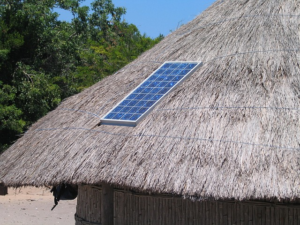
Five public schools in rural communities across Knox and Lincoln counties have started getting most of their electricity from a solar array in the Androscoggin County town of Livermore Falls, federal officials said Monday.
The U.S. Department of Agriculture announced $15.2 million in funding for the 14,000-panel Souther Farm solar array and four others like it in Maine and New Hampshire.
The Livermore Falls installation will provide 96% of the electricity used in the Camden-Rockport School District, Camden Hills Regional High School, Mount Blue Regional School District, Regional School Unit 73 and Hope Elementary School, according to the USDA.
Some of the electricity will also go to the Farmington Water District. In all, the project is expected to produce 6.5 kilowatt-hours of clean energy annually.
ReVision Energy’s solar project is seen Wednesday at the Harold Souther farm in Livermore Falls. Harold Souther is 98 and still lives on his farm but he traded in his cows for solar panels. Russ Dillingham/Sun Journal
For the Five Town School District, Camden-Rockport Schools and School Unit 69, solar-generated electricity goes hand-in-hand with other efforts to lessen the schools’ dependence on fossil-fuel-produced electricity, the districts’ superintendent said.
In addition to electricity from the Souther Farm array, Camden Hills Regional High School gets electricity from a wind turbine and solar panels on the school roof, said Superintendent Maria Libby. Camden-Rockport Middle School gets some of its heat from a sewer thermal project that draws heat from a nearby sewage treatment plant, she said.
The district also just bought an electric school bus paid for in part by a federal grant, Libby said.
“Doing a solar farm was a natural next step for us,” she said, and the range of alternative energy projects powering the schools provides real-life examples for students learning about climate change and efforts to slow it.
“It’s worked really well for us,” she said.
The USDA said it has begun investing $2.7 billion for solar arrays in 26 states. The clean-energy generators will expand and modernize the nation’s rural electric grid, according to USDA.
Solar farms in Maine already generate 553 megawatts of electricity, according to state officials, in projects ranging from rooftop panels to large solar farms.
The Souther Farm project, USDA officials said, will allow the farm family to retain ownership of their land through lease payments for the solar array. And the electricity generated will help lower costs for taxpayers in school districts and Farmington Water District ratepayers. The array was built by Aligned Solar Partners and ReVision Energy.
Rhiannon Hampson, director of rural development in Maine for the USDA, said she hopes more schools will get some of their power from solar energy because that’s a good use of taxpayer dollars – federal spending that can help lower local taxes.
“It checks so …….






